
Sambar, known as Kuzhambu in Tamil Nadu, is a lentil-based vegetable stew, cooked with pigeon pea and tamarind broth. It is popular in South Indian, Sri Lankan and Maldivian cuisines. The stew has been adapted into Burmese cuisine as a popular accompaniment to Burmese curries.

Aloo Gobi, alu gobi or aloo gobhi is a vegetarian dish from the Indian subcontinent made with potatoes (aloo), cauliflower (gobhi), and Indian spices. It is popular in Indian cuisine. It is yellowish in color due to the use of turmeric, and occasionally contains black cumin and curry leaves. Other common ingredients include garlic, ginger, onion, coriander stalks, tomato, peas, black pepper, Asafoetida and cumin. There are a number of variations and similar dishes.

Bhatoora is a fluffy deep-fried leavened sourdough bread originating from the Indian subcontinent. It is commonly served as a midday meal or a breakfast dish in northern and eastern India. Paired with chickpea curry, it forms a traditional dish called chole bhature.
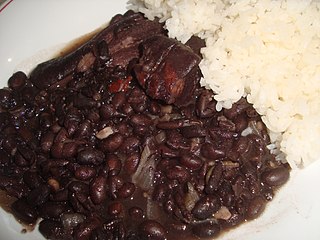
Moros y Cristianos is a traditional Cuban dish served both in homes and in restaurants. It is the Cuban version of rice and beans, a dish found throughout Latin America, the Caribbean, and in the Southern United States.
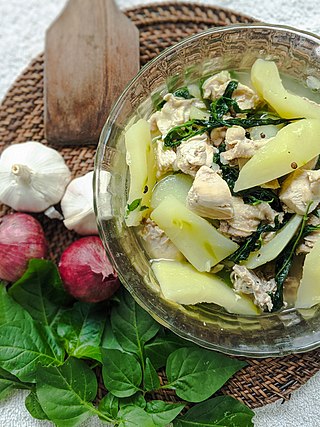
Tinola is a Filipino soup usually served as a main course with white rice. Traditionally, this dish is cooked with chicken or fish, wedges of papaya and/or chayote, and leaves of the siling labuyo chili pepper in broth flavored with ginger, onions and fish sauce.

Goody or goodie is an Irish dessert-like dish made by boiling bread in milk with sugar and spices. It is often given to children or older adults. This dish is eaten on St. John's Eve where it would be prepared near the bonfires lit to celebrate. A variation was prepared using milky tea to soak the bread. This dish is also prepared by parents to give to children when they have an upset stomach. Many children were given this during the 20th century as a treat in neighbours' houses or after school as a snack before dinner. It has nowadays been modified to suit the modern taste, by using cocoa powder and chocolate drops to sweeten.
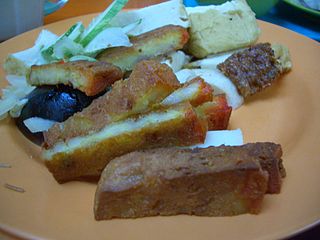
Ngo hiang, also known as heh gernglor bak or kikiam is a unique Hokkien and Teochew dish widely adopted in Indonesia, Malaysia, the Philippines, Singapore, and Thailand; in addition to its place of origin in southern China.

Lor mee is a Chinese Hokkien noodle dish from Zhangzhou served in a thick starchy gravy. Variants of the dish are also eaten by Hokkiens in Singapore, Indonesia, Malaysia and Thailand. In the Philippines, the local variant is called Lomi or Pancit Lomi. The thick gravy is made of corn starch, spices, meat, seafoods and eggs. The ingredients added into the noodles are usually ngo hiang, fish cake, fish, round and flat meat dumplings, half a boiled egg, and other items depending on the stall and the price paid. Vinegar and garlic can be added as an optional item. Lor Mee can be served together with red chili. Traditional versions also include bits of fried fish as topping though few stalls serve this version anymore.

Saltah is a traditional Yemeni dish. Saltah is considered to be the national dish of Yemen. In the Ottoman Empire, saltah was used as a charitable food and was made with leftover food that was donated by the wealthy or the mosques. It is widely eaten in northern parts of the country. It is mainly served for lunch. The base is a brown meat stew called maraq, a dollop of fenugreek froth, and sahawiq. Rice, potatoes, scrambled eggs, and vegetables are common additions to saltah. It is eaten traditionally with khubz mulawah, a Yemeni flatbread used as a utensil to scoop up the dish.
Bourdeto is a fish dish from Corfu. It comes from the Venetian word brodetto, which means 'broth'. It is fish cooked with onion, and red sweet and hot spicy pepper. The best fish for bourdeto is scorpion fish. One can also find the same dish containing fillet of a bigger kind of fish. In Patras and western Greece, the dish is also called "bourgeto"/"bourjeto". In Zakynthos meat is used, instead of fish.

Paddu is an Indian dish made by steaming batter using a mould. It is named variously paniyaram, guliyappa, yeriyappa, gundponglu, bugga, Kuḻi paniyaram, ponganalu, gunta, or Tulu: appadadde, appe. The batter is made of black lentils and rice and is similar in composition to the batter used to make idli and dosa. The dish can also be made spicy or sweet with chillies or jaggery respectively. Paddu is made on a special pan that comes with multiple small indentations.

Bisi bele bhath or bisi bele huliyanna (ಬಿಸಿಬೇಳೆಹುಳಿಯನ್ನ) is a spicy, rice-based dish with origins in the state of Karnataka, India. It is said to have originated in the Mysore Palace and it took a 100 years for the dish to come out of the palace kitchens and another 200 years to spread across the state of Karnataka.
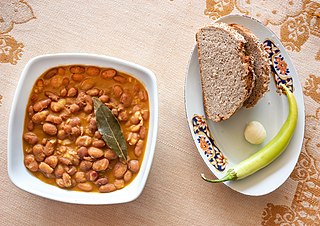
Pasulj, grah (грах) or grav (грав) is a bean stew made of usually white, cranberry or pinto beans, and more rarely kidney beans that is a popular dish in Balkan cuisine. It is normally prepared with meat, particularly smoked meat such as smoked bacon, sausage, and ham hock, and is a typical winter dish. Other commonly used ingredients include carrots and onions. Another version of the dish using baked beans is known as prebranac (пребранац).
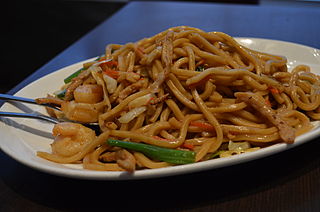
Shanghai fried noodles is a dish made from Shanghai-style noodles, which can be found in most Chinese food markets. The more commonly known Japanese udon can be used as a substitute. The noodles are typically stir-fried with beef cutlets, bok choy, and onion, or with pork and Chinese yellow chives. The dish is a staple of Shanghai cuisine, and is usually served at dumpling houses. In recent years Shanghai fried noodles have become known to western chefs, including celebrity chef Emeril Lagasse.

Sinabawang gulay, usually anglicized as Filipino vegetable soup, is a Filipino vegetable soup made with leafy vegetables and various other vegetables in a broth seasoned with seafood stock or patis. The ingredients of the dish can vary widely. It is eaten on its own or over white rice.

Steak and oyster pie, also known as beef and oyster pie is a traditional Victorian English dish. It is also common in Australia and New Zealand. In Ireland, it has been prepared by the Ballymaloe House, and as a classic dish of the Ballymaloe Cookery School. In the United States, it's a regional dish of Norfolk, Virginia. There, neck, flank, round, or rump may be used. It is prepared in a Dutch oven, where it is slow-cooked until gelatinous. In New Zealand, steak and oyster pie may be made with Bluff oysters. It may also be made with ale. The dish is prepared by Rick Stein using Guinness beer.

Tehri or tahri is a yellow rice dish in North Indian cuisine and Bangladeshi cuisine. Spices are added to plain cooked rice for flavor and colour. In one version of tehri, potatoes are added to the rice.

A carrozza, also referred to as mozzarella in carrozza, is a type of fried cheese sandwich or pastry in Italian cuisine. It is prepared by coating a mozzarella cheese sandwich in egg and flour, and frying it. It is a popular dish in the Campania region of southern Italy and in areas of New York City. Mozzarella fritta is a variation of the dish that consists of battered cheese, without any bread.
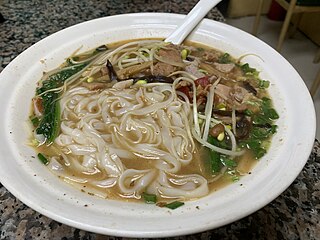
Laoyou rice noodles, which translates as "old friend rice noodles", also referred to as "ol' buddy noodles", is a local noodle dish local to Nanning, China. It is made of fried pepper, sour bamboo shoots, black beans, garlic, pork, soup and rice noodles.

Zatiruha is a Russian soup with handmade noodles. It is a type of paste soup or flour soup. The name comes from the verb тереть ("rub"); the noodles are made by rubbing floury hands together to form pellet-like dumplings or noodles. It is considered a peasant dish. In Belarus the dish is known as zatsirka, in Ukraine as zatirka, and a similar dish called umach ashi is known in other countries. In Polish, the dish is known as "Zacierki" and is usually served as a milk soup.



















